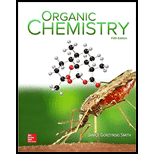
(a)
Interpretation: The number of stereogenic centers present in the product is to be determined.
Concept introduction: A carbon atom which is bonded to four different groups is termed as chiral center or stereogenic center. The groups around the stereogenic center are prioritized on the basis of
(b)
Interpretation: The product formed from the given reaction exhibit optical activity or not is to be predicted and explained.
Concept introduction: The replacement or substitution of one functional group with another different functional group in any
Want to see the full answer?
Check out a sample textbook solution
Chapter 18 Solutions
ORGANIC CHEMISTRY-MOLYMOD PACKAGE
- (a) What product(s) are formed when the E isomer of C6H5CH = CHC6H5 is treated with Br2, followed by one equivalent of KOH? Label the resulting alkene(s) as E or Z. (b) What product(s) are formed when the Z isomer of C6H5CH = CHC6H5 is subjected to the same reaction sequence? (c) How are the compounds in parts (a) and (b) related to each other?arrow_forward2) Draw and name the organic compound found in every reaction. d) Reaction of cis-3,3-Dimethyl-4-propylocta-1,5-diene with two mole of HBr e) Reaction of trans-1-Bromo-3-chlorocyclopentane with potassium hydroxide f) Formation of Gilman reagent using isopropyl bromide g) Ozonolysis of 3,3-Dimethyloct-4-yne h) Complete halogenation (Cl2) of 3-Ethyl-5-methyl-1,6,8-decatriyne i) Partial hydrogenation using Lindlar's Catalyst 2,2,5,5-Tetramethylhex-3-yne j) Reaction of 3,4-Dimethylcyclodecyne with sodium amidearrow_forwardWhich of the following is product of A? How about B? a Cyclopentene oxide b 1,1-epoxycyclopentane c 1,2-hydroxycyclopentane d Cyclopentoxypentane What is the name of reaction 1? a hydration b hydrate formation c acid cleavage d epoxidation What is the name of reaction 2? a ring-opening reaction with Nu b hydration c Williamson ether synthesis d oxidationarrow_forward
- The stereochemistry of the products of reduction depends on the reagent used, as you learned in Sections 20.5 and 20.6. With this in mind, how would you convert 3,3-dimethylbutan-2-one [CH3COC(CH3)3] to: (a) racemic 3,3-dimethylbutan-2- ol [CH3CH(OH)C(CH3)3]; (b) only (R)-3,3-dimethylbutan-2-ol; (c) only (S)-3,3-dimethylbutan-2-ol?arrow_forward(a) Why does p-dichlorobenzene have a higher m.p. than its o- and m-isomers?(b) Why is (±)-Butan-2-ol optically inactive?arrow_forwardWhich isomer reacts more rapidly in an E2 reaction: cis-1-bromo-4-tert-butylcyclohexane or trans-1bromo-4-tert-butylcyclohexane? Explain your answer.arrow_forward
- Draw the structures of the products obtained from the reaction of each enantiomer of cis-1-chloro-2-isopropylcyclopentane with sodium methoxide in methanol. b. Are all the products optically active? c. How would the products differ if the starting material were the trans isomer? Are these products optically active? d. Will the cis enantiomers or the trans enantiomers form substitution products more rapidly? e. Will the cis enantiomers or the trans enantiomers form elimination products more rapidly?arrow_forwardBenzene is one of the compounds used as octane enhancers in unleaded gasoline. It is manufactured by thecatalytic conversion of acetylene to benzene: 3C2 H2(g) ⇌ C6 H6(g). Which value of Kc would make this reactionmost useful commercially? Kc ≈ 0.01, Kc ≈ 1, or Kc ≈ 10. Explain your answerarrow_forwardDehydrohalogenation of 1-chloro-1-methylcyclopropane affords two alkenes (A and B) as products. Explain why A is the major product despite the fact that it contains the less substituted double bond.arrow_forward
- Addition of HBr to allene (CH2=C=CH2) forms 2-bromoprop-1-ene rather than 3-bromoprop-1-ene, even though 3-bromoprop-1-ene is formed from an allylic carbocation. Considering the arrangement of orbitals in the allene reactant, explain this result.arrow_forward4. The products created when 2-methylbut-2-ene reacts with one equivalence of hydrogen chloride arearrow_forward1. Give the major product for the reactions in d and e. 2. Give the name of the structure in f.arrow_forward
 Organic ChemistryChemistryISBN:9781305580350Author:William H. Brown, Brent L. Iverson, Eric Anslyn, Christopher S. FootePublisher:Cengage Learning
Organic ChemistryChemistryISBN:9781305580350Author:William H. Brown, Brent L. Iverson, Eric Anslyn, Christopher S. FootePublisher:Cengage Learning
